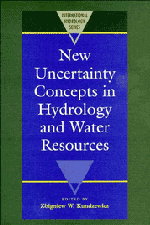Book contents
- Frontmatter
- Contents
- List of Authors
- Preface
- I INTRODUCTION
- II FACETS OF UNCERTAINTY
- III NOVEL APPROACHES TO UNCERTAINTY: FRACTALS, FUZZY SETS AND PATTERN RECOGNITION, NON-PARAMETRIC METHODS
- 1 Dispersion in stratified soils with fractal permeability distribution
- 2 Multifractals and rain
- 3 Is rain fractal?
- 4 Multifractal structure of rainfall occurrence in West Africa
- 5 Analysis of high-resolution rainfall data
- 6 Application of fuzzy theory to snowmelt runoff
- 7 On the value of fuzzy concepts in hydrology and water resources management
- 8 Application of neural network in groundwater remediation under conditions of uncertainty
- 9 Application of pattern recognition to rainfall–runoff analysis
- 10 Nonparametric estimation of multivariate density and nonparametric regression
- 11 Nonparametric approach to design flood estimation with pre-gauging data and information
- IV RANDOM FIELDS
- V TIME SERIES AND STOCHASTIC PROCESSES
- VI RISK, RELIABILITY AND RELATED CRITERIA
9 - Application of pattern recognition to rainfall–runoff analysis
Published online by Cambridge University Press: 07 May 2010
- Frontmatter
- Contents
- List of Authors
- Preface
- I INTRODUCTION
- II FACETS OF UNCERTAINTY
- III NOVEL APPROACHES TO UNCERTAINTY: FRACTALS, FUZZY SETS AND PATTERN RECOGNITION, NON-PARAMETRIC METHODS
- 1 Dispersion in stratified soils with fractal permeability distribution
- 2 Multifractals and rain
- 3 Is rain fractal?
- 4 Multifractal structure of rainfall occurrence in West Africa
- 5 Analysis of high-resolution rainfall data
- 6 Application of fuzzy theory to snowmelt runoff
- 7 On the value of fuzzy concepts in hydrology and water resources management
- 8 Application of neural network in groundwater remediation under conditions of uncertainty
- 9 Application of pattern recognition to rainfall–runoff analysis
- 10 Nonparametric estimation of multivariate density and nonparametric regression
- 11 Nonparametric approach to design flood estimation with pre-gauging data and information
- IV RANDOM FIELDS
- V TIME SERIES AND STOCHASTIC PROCESSES
- VI RISK, RELIABILITY AND RELATED CRITERIA
Summary
ABSTRACT Traditionally human beings predict future runoffs from present rainfalls. One of the recent methodologies of prediction stemming from the pattern recognition technique is presented. The possible range of values of the predicted runoff is estimated by the discriminant functions. The discriminant functions are derived from data sets on several events of rainfall and runoff in the same watershed. The predicted runoff is in good agreement with the observed one.
INTRODUCTION
Forecasting the runoff resulting from a rainfall belongs to the classical basic issues of hydrology. It is shown that the pattern recognition method, which is used in as diverse fields as medical diagnosis, mail problems, banking processes, coastal changes and cybernetics (Mizumura, 1988) is useful also in hydrological forecasting. The method dwells on the obvious statement that much and little rainfall correspond to much and little runoff, respectively.
RAINFALL–RUNOFF PROCESS
The physical system of transformation of rainfall into runoff is very complex. Moreover the runoff consists of three components such as surface flow, interflow, and groundwater flow. Therefore, even if the model strictly described the underlying physical phenomena, it would be difficult to solve the governing equations. The rainfall–runoff process is heavily dependent upon many characteristics of each watershed. For the sake of runoff prediction the rainfall–runoff process is treated here as a black box. Thus, one can employ either of such methods as differential equations, integral equations, least square methods, Wiener–Hopf equation, Kalman filtering etc. Yet another approach originating from the pattern recognition methodology will be tackled here.
Information
- Type
- Chapter
- Information
- New Uncertainty Concepts in Hydrology and Water Resources , pp. 141 - 144Publisher: Cambridge University PressPrint publication year: 1995
